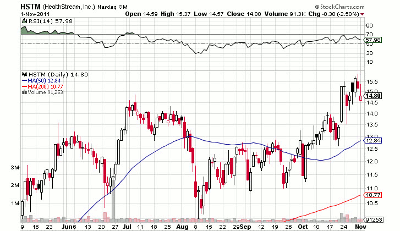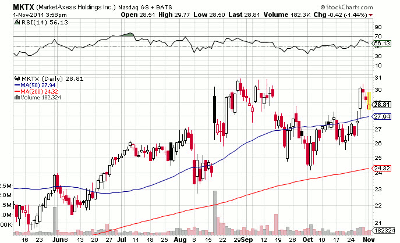Stocks near new highs are often poised for further gains. Current market volatility means extra care should be used with smaller stocks, which could be prone to sudden price swings. However, a proven record of institutional buying can be a bullish signal, writes MoneyShow.com contributor Kate Stalter.
It might seem counterintuitive to track stocks near 52-week highs. After all, according to conventional wisdom, you want to get into stocks that have been sold off and which could represent bargains.
However, as someone who’s primarily a bottom-up growth-style investor, I like to follow the big money: Stocks near new highs have attracted institutional dollars.
Funds are slow-moving vehicles, unlike individual traders. It can take the pros days, weeks, or even months to amass a full position in a stock. That means a new high often leads to still more gains—even if a stock takes a breather and pulls back before resuming its rally.
Generic drug maker High Tech Pharmacal (HITK) ran up to an all-time high of $37.22 in last week’s broad-market rally. Most stocks tend to move in the market’s general direction, and High Tech has been no exception. This week, it retreated along with major indices, but has been acting well, relative to the market.
The stock posted daily declines of about 2% on Monday and Tuesday, but trading volume was below average, and High Tech was holding above its short-term ten-day moving average.
However, there’s a red flag when it comes to the fundamental side: Analysts expect the small-cap to show declines in yearly earnings in 2012 and 2013. Wall Street also sees a mixed picture when it comes to sales growth in the coming quarters.
If the company meets or beats views and offers a bright outlook, the stock can still sport longer-term gains. Many analysts are optimistic about the company’s story, when it comes to drugs in the pipeline and long-term potential for its products.
NEXT: Another Health-Care Performer
|pagebreak|Another health-care name trading just below its 52-week high is HealthStream (HSTM), which makes training software for clinics, hospital, doctor’s offices, and other settings. The stock rallied to an all-time high Monday, but reversed lower amid a general market sell-off.
HealthStream was rallying on Tuesday, bucking losses on the indices. After pulling back from Monday’s high, the stock found support at its ten-day average.
Also worth noting: Weekly volume trends have been constructive. The stock has logged three weeks of heavier-than-normal volume in the past couple of months, as the stock climbed out of its most recent price consolidation.
Meanwhile, weekly downside volume has come in below normal. That’s a sign that buyers have generally had the upper hand.
Sales and earnings growth improved in the past three quarters, following a profit decline in 2010, accompanied by relatively tepid revenue gains. Wall Street sees 2011 earnings coming in at 28 cents per share, a 56% year-over-year increase. In 2012, analysts see another 18% gain, to 33 cents a share.
With the market volatility, HealthStream is a name to watch. If it gets continued support above its 50-day moving average, the stock could offer another technical entry point.
NEXT: A Small Financial Bucking the Trend
|pagebreak|Finally, a little-known company that’s been sporting good technical action is MarketAxess (MKTX). It operates an electronic bond trading platform for institutional clients. Though it’s in the financial sector, it’s not a commercial or investment bank, so has escaped the drubbing that some of its sector peers have received.
It remains to be seen whether contagion from the MF Global (MF) debacle affects MarketAxess. It’s not unheard of for bad industry news to drag down stocks of companies not responsible for the events in question.
MarketAxess went public in 2004, so it still has youth on its side. Stocks whose IPO occurred in the past dozen or so years are generally among the market’s best price performers.
Like many other small caps, MarketAxess has a relatively high beta; in this case, it’s 1.13. In its most recent price consolidation, the stock exhibited some sloppy, erratic trade. While some of that is due to general market swings, the beta indicates that the stock is somewhat more volatile than the benchmark index.
The stock has hit resistance above $30, and may go on to form a handle formation. It’s already getting ten-week support, a good sign. However, selling picked up in the later part of Tuesday’s session, so investors want to see the losses stemmed above key averages.
In addition, better volume to the upside would be a further bullish indicator.
The fundamental story remains promising. Earnings grew at an excellent rate, 55%, in the most recent quarter. Revenue was also solid, rising 24% over the year-earlier quarter. Wall Street expects earnings growth of 54% this year, to $1.23 per share.
In volatile market conditions, small caps can be especially vulnerable to sudden price swings—in either direction. That means these stocks need to be handled with more care than, say, a widely held Dow component with huge institutional ownership.
Nonetheless, a stock trading near a new high has a proven track record of institutional support, and is often setting up for further gains.
At the time of publication, Kate Stalter did not own positions in any of the stocks mentioned in this column.
Related Reading:
The Dow's Most Overbought Stocks
5 ETFs to Navigate the Volatility
The China Factor No Trader Can Ignore













